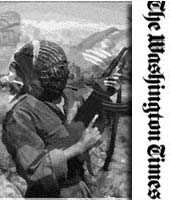As Mujahedin-e-Khalq’s propaganda campaigns and lobbies in the United States government make efforts to gain American politicmen’s support in order to remove the name of their notorious organization from the list of Foreign Terrorist Organizations (FTO) of Department of State, Keneth Timmerman ,a contributing editor for Newsmax Media wrote an article "Timmerman: who are the terrorists?" on The Washington Times enlightening his fellowmen on terrorist nature of Mujahedin Khalq, Timmerman suggests that MEK should never be removed from the FTO list ,accusing MEK of committing terrorist activities against American military personnel and Iranian civilians. While Timmerman presents evidences on MEK’s terrorist nature, he believes that MEK is a more dangerous group than PJAK, another terrorist designated Iranian opposition.
Here is an extract of Timmerman’s article:
By Kenneth R. Timmerman – Washington Times – Tuesday, June 22, 2010
PJAK is a danger only to the Islamic regime
A bipartisan group of House members last week unveiled a resolution in support of the Iranian "resistance," a code word for an opposition group known as the Mujahedin-e Khalq (MEK) that has been on the State Department’s list of international terrorist organizations since its inception in the late 1980s.
"resistance," a code word for an opposition group known as the Mujahedin-e Khalq (MEK) that has been on the State Department’s list of international terrorist organizations since its inception in the late 1980s.
The MEK has a long record of carrying out violent attacks inside Iran. During the period leading up to the 1979 revolution, the group proudly murdered U.S. military officers and civilians working in Iran. And while the group’s current leadership and its apologists claim that those attacks were carried out by a splinter group no longer associated with the MEK, eyewitnesses tell me that the MEK continued to celebrate the anniversary of those murders in ceremonies and song in their training camps inside Iraq all through the 1980s.
In the power struggle that followed the 1979 revolution, the MEK actively promoted the seizure of the U.S. Embassy in Tehran and planted a bomb that wiped out the leadership of the Islamic Republican Party led by Ayatollah Mohammad Beheshti, arguably the last of the "moderate" leaders of the revolution.
More recently, MEK operatives inside Iran have carried out hit-and-run terrorist attacks on regime officials and have planted bombs in urban areas that have randomly killed civilians. The MEK and its supporters call these attacks acts of "resistance" against the regime.
Senior State Department officials have stated that their condemnation of the MEK’s use of random violence against civilians stems from a desire not to use a "double standard" when it comes to terrorism. The MEK and its supporters claim that keeping the MEK on the State Department’s list of international terrorist organizations benefits the Iranian regime. Some even argue, incorrectly, that the group was placed on the list in 1994 by the Clinton administration as a sop to the regime. (While the Clinton folks kept the MEK on the list in hopes it would encourage a rapprochement with Tehran, the MEK was placed on the list years earlier).
Contrast the MEK’s record of random violence against civilians with the use of violence by the Free Life Party of Iranian Kurdistan, PJAK, a group that was designated by the Treasury Department as a terrorist organization in February 2009.
PJAK guerrillas operate inside Iran in trained groups. Their primary mission is political: That is, they seek to spread a message that Iranian Kurds must abandon tribalism and traditional politics if they want to aspire to democratic self-governance.
Indeed, at PJAK camps I visited in northern Iraq in October 2007, the emphasis was on the political indoctrination of new members, not military training. PJAK prides itself on its inclusiveness: More than 30 percent of its guerrilla fighters and leadership are women.
PJAK makes no bones about its use of violence. Indeed, a Google search of the terms "PJAK attack" results in dozens of incidents in which PJAK guerrillas have attacked Iranian military targets and bases inside Iran. Almost all of these attacks have targeted the Revolutionary Guard Corps.
But PJAK uses violence in defense of the Kurdish population, not as an instrument of terror against civilians. In contrast to the MEK, PJAK has never planted bombs in public areas or targeted regime officials for assassination.
By Mazda Parsi
